Introduction, Specifications, and Pricing
64-layer flash was the great equalizer allowing Toshiba and Micron to close the performance gap on Samsung's V-NAND technology. The next step builds the stack in 96-layer formations while increasing the memory bus speed again. Today, we look at Toshiba's next-generation high-performance NVMe SSD featuring 96L memory but don't expect to find this one on Newegg soon. The XG6 will go to big box system builders first, and we may see a retail variant at a later period.

The Toshiba XG6 is the replacement for the XG5 but not the upmarket XG5-P currently shipping in high-performance workstations. The new XG6 is faster than both XG5 variants but lacks an important feature many workstation-class users require, a 2-terabyte capacity model for large datasets.
Since you can't buy the new Toshiba XG6 as a standalone purchase, our review will serve as a technology preview of the BiCS4 96L memory and a look at what OEM notebooks and desktops currently ship with from the factory. From time to time, we do see Toshiba OEM SSDs listed on EBay and Amazon from gray market sellers.
At Flash Memory Summit 2018 less than a month back, Toshiba displayed a number of notebooks shipping with these and other Toshiba SSDs. The wall had the big box names like Dell and HP. The existing customers will likely be the first to ship products with the new XG.
Specifications
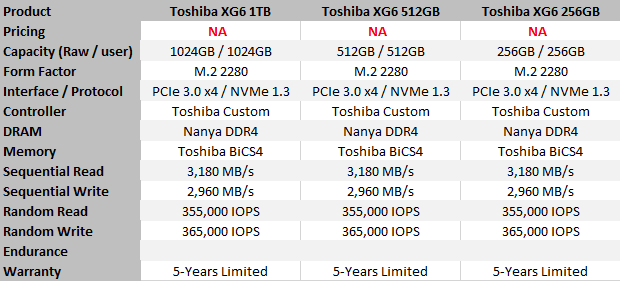
Toshiba announced the XG6 in three capacities earlier this year. The series doesn't overprovision the drives from the factory, so users get the full binary capacity unless the system builders use supported NVMe commands to change the user to reserve ratio. The XG6 is one of the few NVMe SSDs that officially supports this command.
We will see XG6 in 1TB, 512GB, and 256GB capacities. The performance claims are the same for all three sizes, with sequential read at 3,180 MB/s and sequential write at a blistering 2,960 MB/s. This improves on the XG5 with 3,000 MB/s, and 2,700 MB/s read and write speeds.
Random performance saw a sizable improvement as well. The XG6 delivers it up to 355,000 read and 365,000 write IOPS performance. Toshiba never listed the random performance on the XG5 because it varies by firmware and application. The OEMs can lower random performance via firmware to increase power efficiency. System builders can still work with Toshiba on custom firmware to achieve specific performance and power efficiency targets.
Features
Toshiba offers the XG6 in two versions, with and without self-encryption drive (SED) technology. That files out the options, but that's not the end of the story.
At the heart of the XG6 is Toshiba's TC58NCP090GSD controller. This is the same controller found on the XG5 and XG5-P. Toshiba doesn't disclose too much about the controller architecture, but we assume it features a standard 8-channel design given the performance. The physical difference between the older and generation and new XG6 is the 96-layer flash.
Toshiba's 96L "BiCS4" memory is the first from the company to utilize Toggle3 specifications. The flash bus speed increases up to 800 MT/s and increases performance without increasing the core clock in the controller. The XG6 utilizes a 3-bit per cell configuration, but the company plans to add a BiCS4 4-bit per cell to the lineup in the future. That memory will not go in the XG6 but instead, it will go in an undisclosed product that we hope to see in the near future.
A Closer Look

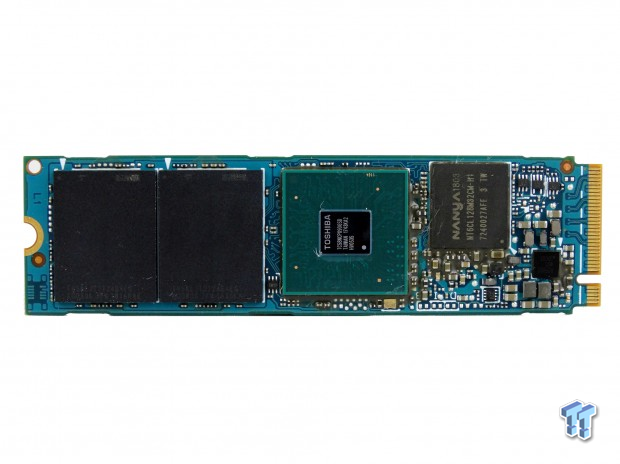


We found the top cover plate attached with witchcraft and strong double-sided tape. At first, we thought the cover plate was metal to help dissipate heat from the controller, so we were very careful about removing it. Metal will crease, and it's nearly impossible to get straight again. Once off, we realized it's plastic. It will help to deflect radiant heat from nearby video cards and other hot devices. It won't do much to aid cooling of the SSDs components.
1TB Class Performance Testing
Product Comparison

As an OEM specific drive, the Toshiba XG5 has been off our comparison drive list for quite a while now. We'll add the drive in with a few results to see how it compares to its successor, the XG6.
The charts show performance from the most popular mainstream and premium NVMe SSDs shipping today. The Adata SX8200 and HP EX920 both utilize Silicon Motion's SM2262 controller paired with Micron's 64L TLC memory.
The Plextor M9Pe and SanDisk Extreme Pro NVMe both utilize Toggle2 memory from Toshiba and manufacturing partner SanDisk/Western Digital.
The other two drives everyone knows from Samsung with the Phoenix controller and 64L V-NAND. The 970 Pro is the only drive in this review with 2-bit per cell MLC flash.
Sequential Read Performance


The 1TB XG6 starts off the sequential read test surprisingly low with around 1,350 MB/s at queue depth (QD) 1. The performance increases rapidly, as we increase the workload through queue depth. By QD4 the drive is near peak performance with a single worker right around 3,200 MB/s.
Sequential Write Performance

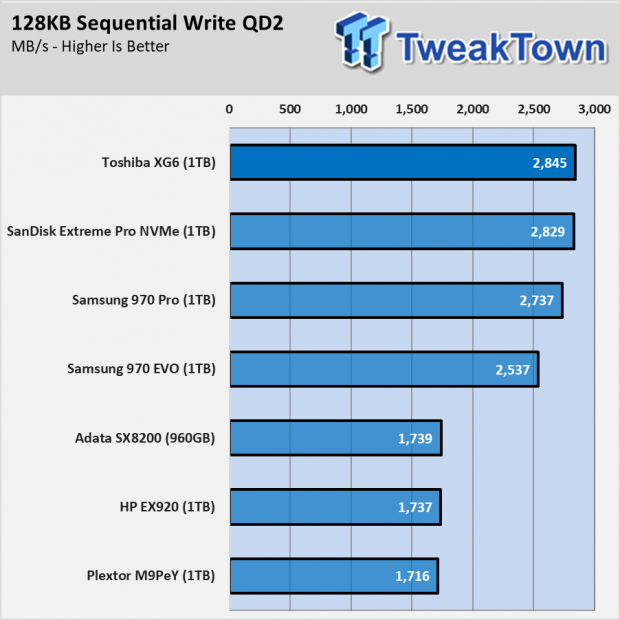
Oh my. The 1TB Toshiba XG6 rips through the sequential write test with a very high QD1 speed and insane peak performance that climbs all the way to 3,000 MB/s with a single worker. Toshiba managed to squeeze more sequential write burst speed out of the new Toggle3 memory than Samsung's MLC V-NAND found on the 1TB 970 Pro.
Sustained Sequential Write Performance
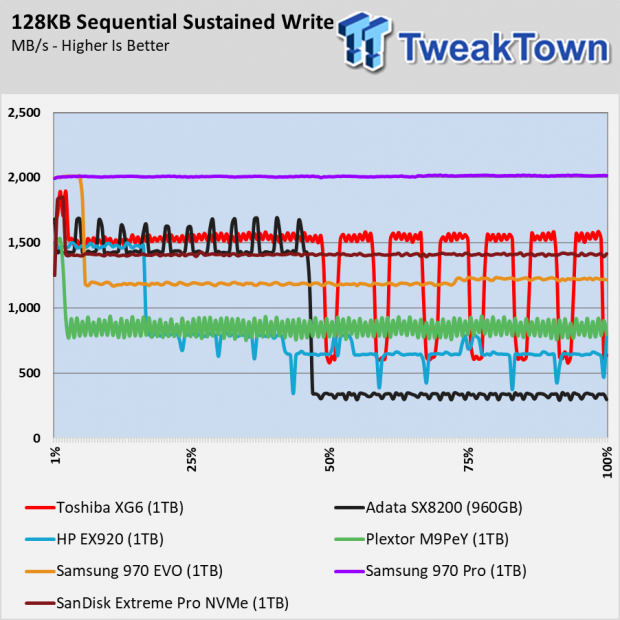
Writing 128KB block data to the entire user area exposes an issue we found on the XG5 that carries over to the XG6. The SLC buffer area performance is very high, the sustained performance is also high, but it's possible to reach a thermal throttle condition before we fill the drive with data.
We were able to write more than 512 gigabytes to the drive before the drive throttled.
Random Read Performance


Our only expectation for Toshiba's new 96L TLC was improved random read performance at low queue depths. Micron ran away from the competition with 64L TLC with the MX500 SATA SSD, and a number of third-party NVMe drives like the SX8200 and EX920 shown in the charts today.
The Toshiba XG6 did not reach the 15,000 to 17,000 random read IOPS range at QD1, where we find the Micron 64L TLC and Samsung 64L MLC. The XG6 gets within 1,000 IOPS to Samsung's 970 EVO at QD1.
Random Write Performance

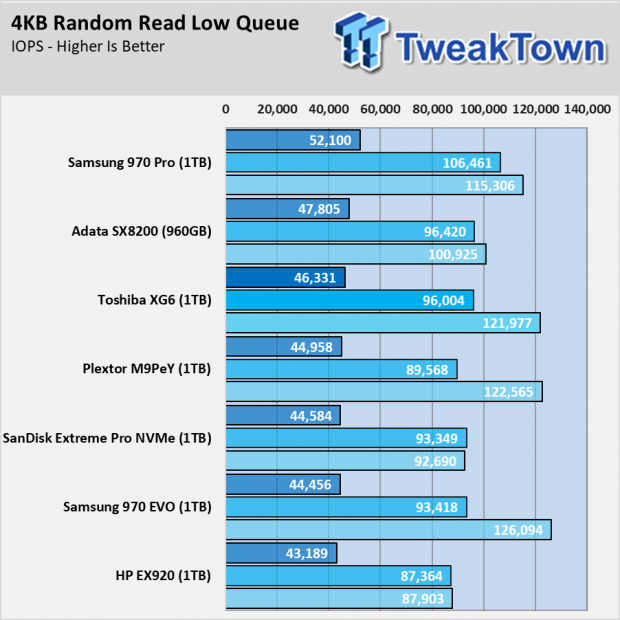
The random write performance is stellar with high and predictable performance through the queue depth range. We expect Toshiba SSDs to perform really well here. The company's products have historically been some of the best-working SSD's with random data writes.
70% Read Sequential Performance
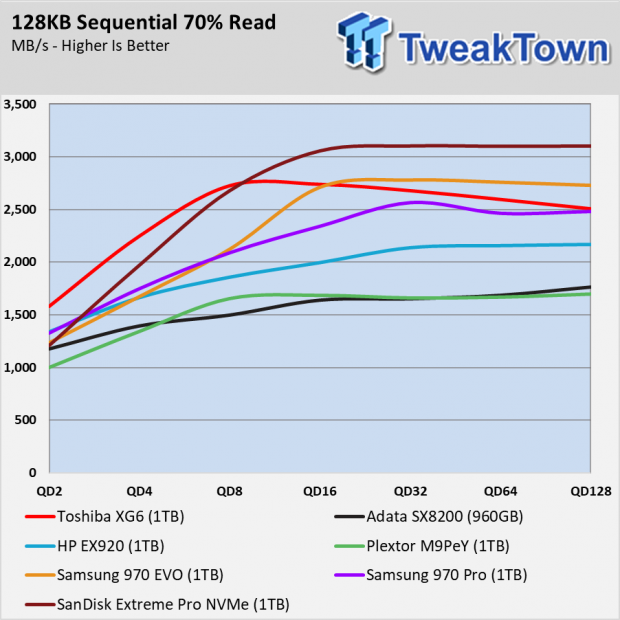

Toshiba has a few other areas where we expect high performance. Mixing reads and writes is another one. In the sequential mixed workload test with 70% writes the XG6 outperforms the other drives from QD2 to QD8. The difference is more than trivial; this is a substantial increase over the median performance of the other drives in the charts today.
70% Read Random Performance


With random performance on the lower-end of the scale, the XG6 has an uphill climb to get near the top in the random mixed workload test. The drive has strong random write performance, but that's not enough to overcome the 70% reads. The performance is still very good, but its less than we hoped to see with the latest generation Toshiba NVMe SSD.
1TB Class Real-World Performance Testing
Game Load Time

High sequential performance looks good on paper, but random performance is what makes your applications load quickly and gives you a pleasurable user experience. Many of the tests on this page rely on strong random read performance.
The Game Load Time Test using Final Fantasy: Stormblood shows just how close all of these drives are together with real-world applications. Who would have guessed this is the performance that now ships in new notebooks?
PCMark 8 Total Storage Bandwidth
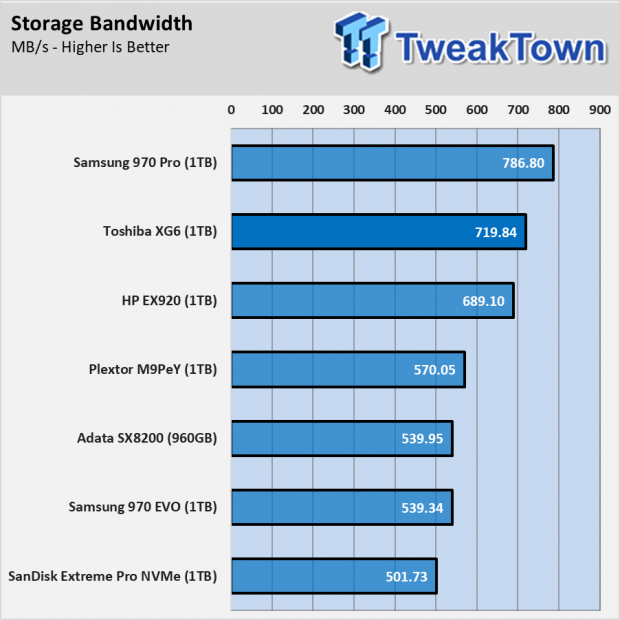
We are also impressed with the general use applications. PCMark 8 utilizes ten general applications that range from Battlefield to Word. We measure the performance and present it as a combined throughput score. The 1TB XG6 performs much better than we anticipated given the lower random read performance we observed on the previous page.
PCMark 8 Extended Storage Test
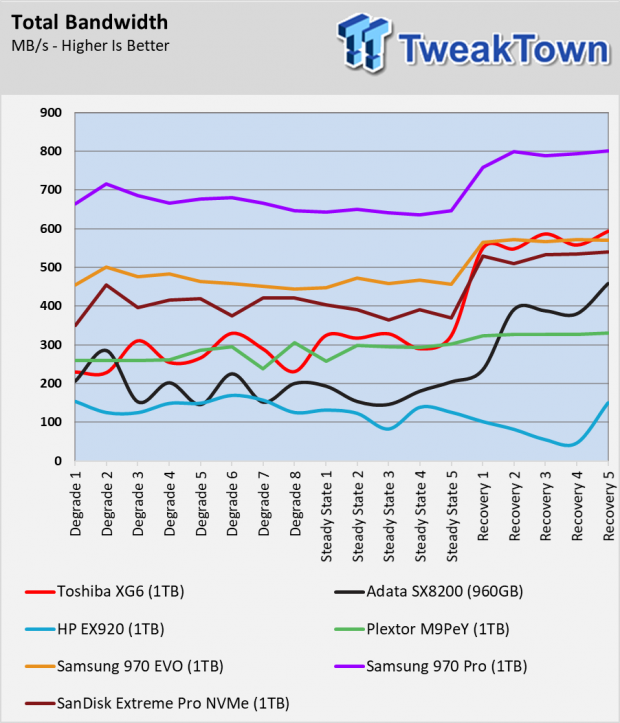
The XG6 doesn't have any issues recovering performance coming out of a heavy-wear state. Some of the drives with newer controller technology sometimes have issues with recovery. This is due to using fewer cores in the controller to make them more affordable. Toshiba doesn't tell us a lot about the architecture, so we don't know the number of cores, or even the number of channels. What's important is the XG6 has enough to recover in a short period of time.
SYSmark 2014 SE System Responsiveness and Power Tests
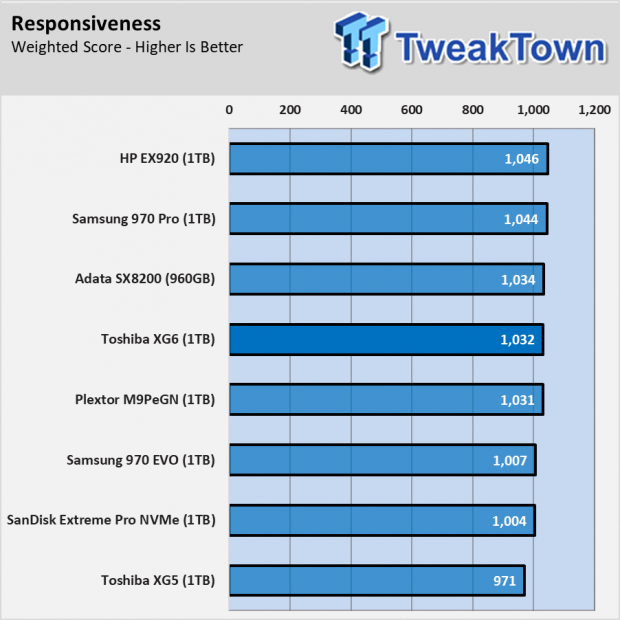

This is the first test we included the 1TB XG5 to compare with its successor, the XG6. The SYSmark 2014 SE Responsiveness test measures storage latency, the stuff that makes us pull our hair out. The XG6 is a substantial success to the XG5 with a massive sixty-one point difference in the Responsiveness test. We also observed better overall system power efficiency over the XG5.
Notebook Battery Life

The 1TB XG3 didn't break any records for notebook battery life performance. We have to assume Toshiba configured the press samples for throughput performance and didn't detune the drive any to deliver a lot of battery time. We've known for a while that large OEMs can and often do request certain performance caps to meet target battery life numbers, but our sample isn't capped. We are one of, if not the only site to look at notebook battery life with MobileMark 2012 1.5.
Final Thoughts
With drives like this in prebuilt systems, we have to wonder how long there will be an aftermarket for storage. Let's not worry about that just yet, though. The gaming and enthusiast market is on an upswing. NVMe SSDs are still fairly expensive compared to what they could be and system builders still charge outrageous premiums for them over SATA. We're not too worried just yet because the best way to buy a prebuilt system is to get it with the cheapest storage option and then add your own drive for less than half the price the OEM charges.

The upgrade method doesn't work for everyone and I'm sure Toshiba will sell a lot of XG6 SSDs. What the company hasn't talked about is this drive, or a possible XG6-P, coming to the consumer market under the old RevoDrive series name. We're about a year past when Toshiba should have released a successor to the RD400. Around a year and a half ago, there were some rumors and muttering about a RD500, but that never materialized.
If you went back through the review to replace every XG6 with RD500, and gave it a reasonable price, we all be more than happy. The XG6 really should be the base for a retail consumer SSD. If there is a place to release a XG6-P with even higher performance, we'll take that as an RD500 without any complaints.
As for now, the XG6 is a system builder drive that you can't buy without getting a full system. We hope that changes at some point because this is a very capable and competitive NVMe compared to what's available today. With that in mind, there isn't much else we can say about the XG6. If you are lucky enough to get this drive in a notebook or desktop we think you will be happy with it.

 United
States: Find other tech and computer products like this
over at
United
States: Find other tech and computer products like this
over at  United
Kingdom: Find other tech and computer products like this
over at
United
Kingdom: Find other tech and computer products like this
over at  Australia:
Find other tech and computer products like this over at
Australia:
Find other tech and computer products like this over at  Canada:
Find other tech and computer products like this over at
Canada:
Find other tech and computer products like this over at  Deutschland:
Finde andere Technik- und Computerprodukte wie dieses auf
Deutschland:
Finde andere Technik- und Computerprodukte wie dieses auf